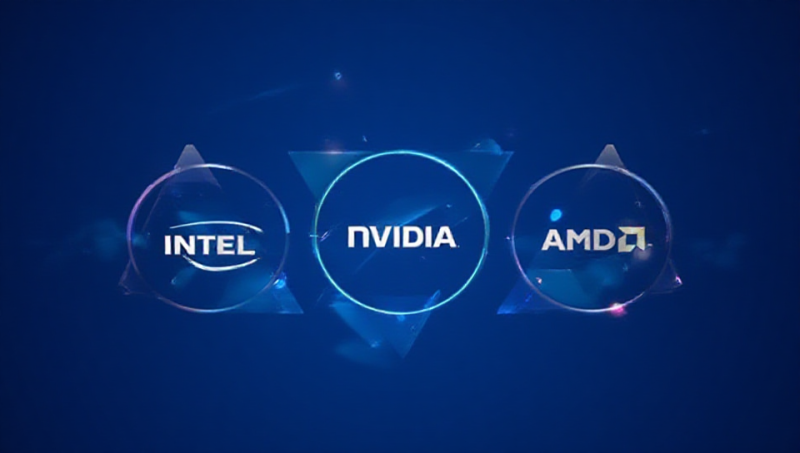Title: The Battle for AI Hardware Supremacy: NVIDIA vs. AMD and Intel in 2025
Artificial Intelligence (AI) is transforming industries across the globe, and at the heart of this transformation lies the hardware that powers these advancements. Three major players—NVIDIA, AMD, and Intel—are vying for dominance in this rapidly evolving field. While NVIDIA has long been the leader, AMD and Intel are making bold moves to challenge its position. In this article, we’ll explore the strategies, strengths, and challenges of these companies, providing a comprehensive look at the AI hardware market in 2025.
Introduction: Why AI Hardware Matters
The hardware powering AI models is the foundation of modern technological innovation. From training large language models like ChatGPT to enabling edge computing in IoT devices, AI hardware facilitates rapid computations, high-throughput processing, and seamless integration of AI technologies into various applications.
NVIDIA’s GPUs (Graphics Processing Units) have set the standard, becoming essential tools for researchers and businesses alike. However, AMD and Intel are aggressively positioning themselves as contenders, pushing the boundaries of innovation to capture market share.
Background: The Players and Their Ecosystems
NVIDIA: The Unquestioned Leader
NVIDIA’s dominance in AI hardware stems from its high-performance GPUs and the CUDA platform, a proprietary software ecosystem that has become the industry standard. CUDA’s libraries, frameworks, and community support provide developers with everything they need to create and optimize AI models.
Examples of NVIDIA’s Impact:
- Data Centers: GPUs like the A100 and H100 power AI applications in cloud services such as AWS, Google Cloud, and Azure.
- Research: NVIDIA’s hardware is the backbone of breakthroughs in fields like genomics and autonomous vehicles.
- Consumer AI: Technologies like DLSS (Deep Learning Super Sampling) bring AI-powered graphics enhancements to gaming.
AMD: Innovating with Open Ecosystems
AMD’s approach focuses on offering competitive performance at a lower cost, with an emphasis on open-source solutions. The ROCm platform is AMD’s answer to CUDA, designed to provide developers with an open and accessible alternative for AI workloads.
Notable Moves by AMD:
- Ryzen AI Processors: Bringing AI to consumer PCs for applications like real-time transcription and personalized recommendations.
- MI300 Series: Targeting high-performance computing (HPC) and AI training workloads.
- Nod.ai Acquisition: Strengthening its AI software capabilities.
Intel: Diversifying AI Hardware
Intel is taking a multifaceted approach, focusing on both traditional CPUs and specialized AI accelerators. Their oneAPI initiative aims to unify programming across various hardware types, simplifying AI development.
Intel’s Key Developments:
- Core Ultra Processors: Integrating AI capabilities into everyday computing devices.
- Gaudi AI Accelerators: Offering specialized hardware for training large AI models.
- Quantum Computing Research: Exploring the next frontier of AI hardware.
The Current Landscape: Market Trends and Statistics
The AI hardware market is projected to grow significantly in the coming years, driven by increasing demand for AI applications. According to Statista, the global AI hardware market is expected to reach $826.70 billion by 2030.
Market Share Breakdown (2024 Estimates):
| Company | Market Share | Key Strengths |
|---|---|---|
| NVIDIA | 78% | Ecosystem, performance, developer trust |
| AMD | 12% | Cost efficiency, open-source focus |
| Intel | 10% | Broad hardware portfolio, edge AI |
Key Growth Areas:
- AI-Enabled PCs: Bringing AI capabilities directly to consumer devices.
- Edge Computing: Deploying AI in real-time applications like autonomous vehicles and IoT devices.
- Sustainability: Developing energy-efficient AI hardware to meet environmental goals.
Challenges Ahead for AMD and Intel
1. Software Ecosystem Gap
NVIDIA’s CUDA platform remains the gold standard, with robust support for AI frameworks like PyTorch and TensorFlow. AMD’s ROCm and Intel’s oneAPI, while promising, are still maturing.
Potential Solutions:
- Incentivizing Developers: Offering grants and partnerships to encourage developers to adopt alternative platforms.
- Enhancing Compatibility: Ensuring seamless integration with popular AI tools and frameworks.
2. Performance and Efficiency
NVIDIA’s GPUs consistently outperform competitors in benchmarks. AMD and Intel must close this gap by focusing on:
- Hardware Optimization: Leveraging advanced manufacturing techniques to improve performance.
- Energy Efficiency: Addressing growing concerns about the environmental impact of AI.
3. Market Perception and Brand Loyalty
NVIDIA’s reputation as a trusted leader makes it difficult for AMD and Intel to attract enterprise customers.
Strategies to Overcome This:
- Specialized Solutions: Targeting niche markets where NVIDIA’s presence is weaker.
- Aggressive Marketing: Highlighting cost advantages and unique features.
Opportunities for AMD and Intel
AI for Consumer Devices
Both companies are integrating AI into consumer-grade hardware. For instance, AMD’s Ryzen AI processors enable features like real-time language translation, while Intel’s Core Ultra chips aim to power intelligent assistants.
Edge Computing
The demand for AI in edge devices is growing. Applications include:
- Autonomous Vehicles: AI-powered navigation and decision-making.
- IoT Devices: Real-time data analysis in smart homes and industrial settings.
Sustainability as a Differentiator
Developing energy-efficient AI hardware could attract eco-conscious enterprises. For example, AMD’s focus on high-performance, low-power chips positions it well in this area.
Future Implications
The competition among NVIDIA, AMD, and Intel will drive innovation, reduce costs, and expand access to AI technologies. However, the landscape could shift with:
- Quantum Computing: Intel’s investments in quantum technology could redefine what’s possible in AI.
- Open-Source Platforms: Wider adoption of ROCm and oneAPI could challenge CUDA’s dominance.
- New Entrants: Startups and emerging players could disrupt the market with novel approaches.
Conclusion
NVIDIA’s lead in the AI hardware market is significant, but AMD and Intel are positioning themselves as formidable challengers. Their focus on consumer devices, edge computing, and sustainability highlights the diverse opportunities in the AI landscape. For developers, researchers, and businesses, these advancements promise more choices, better performance, and lower costs.
What are your thoughts on the future of AI hardware? Share your opinions in the comments below!

















